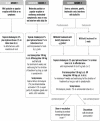Adverse events associated with anti-EGFR therapies for the treatment of metastatic colorectal cancer
- PMID: 20680104
- PMCID: PMC2901793
- DOI: 10.3747/co.v17is1.615
Adverse events associated with anti-EGFR therapies for the treatment of metastatic colorectal cancer
Abstract
The epidermal growth factor receptor (EGFR), a member of the ErbB family of receptor tyrosine kinases, plays an important role in the control of cell growth and differentiation. Disruption of its signaling leads to neoplastic cell proliferation, migration, stromal invasion, resistance to apoptosis, and angiogenesis.EGFR is overexpressed in a variety of solid tumors, including colorectal cancer (CRC), and its overexpression is associated with poorer prognosis. One class of agents that is currently used to target EGFR in the treatment of metastatic CRC (mCRC) is the monoclonal antibodies. While the monoclonal antibody EGFR inhibitors lack many of the severe side effects commonly observed with cytotoxic chemotherapy, they are associated with a set of unique dermatological toxicities. This paper reviews the safety profile of the anti-EGFR monoclonal antibodies cetuximab and panitumumab in the treatment of mCRC.
Keywords: cetuximab; epidermal growth factor receptor; panitumumab; skin toxicity.
Figures
References
-
- Di Marco E, Albanese E, Benso S, et al. Expression of epidermal growth factor receptor and transforming growth factor alpha in human larynx carcinoma. Cancer Lett. 1992;65(3):189–99. - PubMed
-
- Salomon DS, Brandt R, Ciardiello F, et al. Epidermal growth factor-related peptides and their receptors in human malignancies. Crit Rev Oncol Hematol. 1995;19(3):183–232. - PubMed
-
- Miettinen PJ, Berger JE, Meneses J, et al. Epithelial immaturity and multiorgan failure in mice lacking epidermal growth factor receptor. Nature. 1995;376(6538):337–41. - PubMed
-
- Klapper LN, Kirschbaum MH, Sela M, et al. Biochemical and clinical implications of the ErbB/HER signaling network of growth factor receptors. Adv Cancer Res. 2000;77:25–79. - PubMed
-
- Alroy I, Yarden Y. The ErbB signaling network in embryogenesis and oncogenesis: signal diversification through combinatorial ligand-receptor interactions. FEBS Lett. 1997;410(1):83–86. - PubMed
LinkOut - more resources
Full Text Sources
Other Literature Sources
Research Materials
Miscellaneous


